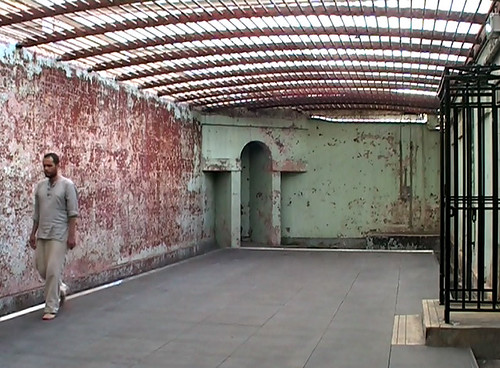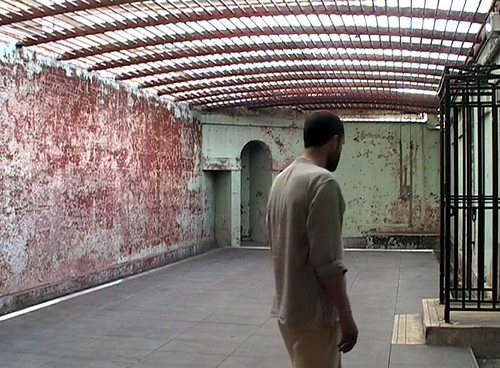The image below shows (on the left) an earlier work about Belzec (1 to the power of 500,000) from 2010, and on the right, what would be a video (using the same number of squares) derived from the video filmed at Belzec in 1999.
Belzec Video: Snow 5
The same idea as before applied to footage of trees at Belzec. The number of squares used is the same as an earlier work.
Belzec Video: Snow 4
Video version of that described in the previous entry regarding this project.
Belzec Video: Snow 3
What interests me about the video footage from the archaeological dig at Belzec (1999) is the sense of colour and movement. Often, when one is researching the Holocaust and sites like Belzec, most of the imagery one encounters is black and white and often still (although of course there is a great deal of moving footage as well).
As I’ve said, it’s difficult, given the quality of the footage, to make anything that would resemble a narrative of the investigation carried out there. So taking the idea of colour and movement as something I wanted to work with, I decided to process the video and to use a mosaic filter to reduce the image to pure forms.
When I was an undergraduate in the early 1990s, I produced a series of paintings based on this idea in a work entitled ‘A Single Death is a Tragedy, a Million Deaths is a Statistic.’ I was looking at the idea of anonymity and the past as anonymous (something which I’m still looking at today) reducing the image of a man, through a series of canvases to a single coloured pixel.
One of the ways of understanding an event as horrific as the Holocaust on an empathetic level (as far as is possible) is through understanding that the past was once the present that what happened in places such as Belzec happened when the past was now. When I sit here now and look out the window, I see the trees move, I see their colours, I see the sky, the clouds drifting and so on. I see movement and colour.
Whenever I look at images of the past, especially those in black and white, I try to imagine the scene as if it was now. I colour it, I imagine what happened immediately after the shutter was released. The smallest details become especially important. When I myself visited Belzec in 2007, I was aware of the world moving all around me, of the trees especially; of the sounds they made and the colour. Putting this together with what I knew had happened there, enabled me in some small way to empathise with those who died.
The stills below are taken from the processed video and even though they reduce the place to pixels (and therefore render it anonymous) there is something about the individual squares of colour which serve somehow to represent both the anonymous individual and the nownes of the present.
Belzec Video: Snow 2
Edited footage shot in 1999 at the site of the former Belzec Death Camp in Poland. The footage is of very poor quality and as an artist, I’m looking at how it might be used in my own work.
Belzec Video: Snow
About two years ago I was given recordings of an archaeological investigation at the site of the Belzec Death Camp in Poland (1999). These investigations were carried out prior to the construction of the memorial there and my task was to edit the videos into something that could be seen as a narrative of those events.
The videos however were less than brilliant and any documentary-type video was going to prove impossible. However, I wanted to work with the video in some way or another and in 2010, as part of Holocaust Memorial Day, I exhibited a number of images based in part on the original video.
This year, I want to make a piece based on the video and the stills I exhibited in 2010. The initial idea is to capture all the pieces of ‘snow’ from the recordings and to arrange them in a sequence. The ‘snow’ represents the end of something, and it’s the idea of something ending which interests me as regards this piece.
Eventually I will develop the video using the colour/documentary footage on the tapes, intercutting them with the ‘snow’ elements. I will put up extracts of each stage as and when they’re complete.
Below is a short extract of the snow sequence.
A Walk of 4,342 Steps
The video-based performance piece I want to make involves my walking around the exercise yard – in this case for about an hour. The ‘Walk of 4,342 Steps’ refers to a walk I did on 31st October (the first walk in a series of 9 made during the residency) and the final video will comprise my walking with details of the walk read out over the top.
The following stills are taken from the video.
As I walked, and as I felt my body tense up and stiffen (in particular my jaw for some reason) I found myself listening to the sounds from outside, coming through the bars in the ceiling. Again this seemed to illustrate my work, as regards the idea of the constrained walk being analogous to history’s relationship with the past, where the wider past can only be ‘glimpsed’ to some degree through the bars.
Light
This evening I started filiming – for documentary purposes – my work on creating the templates for the ‘sail’ which I will start to sew soon. As I set up the video, I noticed, in the corner of the room, a patch of light on the wall and the floor. It reminded me of the paintings of Hammershoi, such as the image below which I wrote about in a previous blog entry back in March this year.
I put the video camera on the patch and started filiming for a couple of minutes, but as I watched the subtle changes in light I decided to leave it running until the tape ran out some 50 minutes later. The results were rather beautiful; an illustration of the passing of time, the end of a day and the the ‘nowness’ of the present – something which Hammershoi reveals beautifully in his paintings. Although painted at the beginning of the 20th century, the patch on the light keeps them very much a part of the present – the shape of the light cast by the window is something with which we are all familiar.
The stills below – taken from the video – show the light over a period of about 50 minutes.
Umbilical Light II
I started working on the project today using some VJ Sofware called Resolume which allows for comprehensive realtime effects changes etc. using MIDI and received audio signals. Parameters of effects such as blurring (which I have used in this project) can be determined by the frequency range of the received audio signal which means one can get some very nice results quite quickly.
I started by using details of photographs which I’d scanned from a book of old Oxford photographs. The published images are not so great so the details are even less so, but nevertheless this added somewhat to the progression of the work.
What I couldn’t help but see when I was working on the piece, using all manner of synths to make the desired noise (which I haven’t quite achieved as yet) was how the photographs when manipulated in this way became x-ray photographs of internal organs which, given the title of the projects seemed very apt.
The following photographs are the three main images I used:

Taken in what is now South Park in 1903 
Taken in Queen Street c1900 
Taken in St. Clements c1910
The following are stills created using synthesizers (my old Roland XP60 as well as Reaktor and Absytnth) and Resolume.

For me, the image looked like a heart and when I manipualted the video using a basic bass drum pattern, it really worked. Below is a video file showing a part of the work – unfortunately without the sound.
















